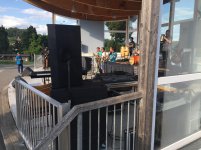double 10" hornloaded low-mids with Faital 10FH500 (100-700Hz) + BMS4590 Coaxial Mid/High (700Hz/7kHz) with Limmer 033 horn (60x40), all selfpowered with Pascal X-Pro3 Class D Amps + 64Bit/96kHz DSP from AllDsp (Germany).
using 3 TH18 the input of the top is set to 0dB, using 2 subs it's -3 dB and when using only one TH input gain is -9dB. works well...
Do the TH18s sound good up to 100hz? Do the double 10's have enough output at the xover to keep up? Do you have a pic of the tops and of your set up you could post? I have considered the Coax BMS drivers for future tops, are they as good as everyone says? I see they recommend a xover of 300hz yet they don't even graph its output at 300hz. If I went by their graph I would not xover any lower than 500hz. I see you are at 700hz. How are the Pascals vs the Powersoft amp modules? Sorry for the questions, you just seem like you have put lots of time and effort and money into your system and have accomplished what I am trying to do.
Can anyone recommend some good casters that will work well with this design?
Thanks!
Any Standard Bluewheel 100mm will do fine. Depending on where you live on the planet, different suppliers are recommended - but hitting "Blue wheel 100" in your shppoing search engine should pop up something. Guitel, Penn Elcom, Tente, Blickle....
Do the TH18s sound good up to 100hz? Do the double 10's have enough output at the xover to keep up? Do you have a pic of the tops and of your set up you could post? I have considered the Coax BMS drivers for future tops, are they as good as everyone says? I see they recommend a xover of 300hz yet they don't even graph its output at 300hz. If I went by their graph I would not xover any lower than 500hz. I see you are at 700hz. How are the Pascals vs the Powersoft amp modules? Sorry for the questions, you just seem like you have put lots of time and effort and money into your system and have accomplished what I am trying to do.
Hi
some answers to your questions:
yes they do. i cut them at 80Hz/12 dB BW. upper resononances i cut separately with additional parametric filters. i generally use no steep filters to avoid an excess of group delay. below 80Hz there is just a little EQing. They do everything right. the Faital 18HP1060 is a excellent driver. everyone who heard the TH18 said that there was a big difference in sound in the meaning af MUCH BETTER compared to standard vented subs. the coolest thing is that these subs are sounding perfect at any level. you can play with background levels and you will get the same fat sound like playing on limit.
i had the fear the low-mids wouldn't match but that wasn't the case. at least at shorter distances up to 20m the do very well. i have to measure the set at long distance.
i will post some pics of the top. but first i have to take away the grills to take a foto from the horn.
the reasons why i took the BMS4590: first of all there was a friend who told me only the best about this driver. i wanted to have a Top with good low-mids and real point-source behavior. i also can't stand distortion. for me a real D'Appolito setup and a coax driver is a natural thing which comes next to a real point source (at least if you know nothing about Synergy Horns
i don't know if you can go down to 300Hz. maybe you can do that with a large horn. i think distortion will increase dramatically. not so good for PA.....
the Pascals are state of the art. Pascal had a long-time collaboration with Camco Germany. now they made a buyout and Camco was purchased by L'acoustics last year. They all use the same tecnology in their amps (so called UMAC technology, pat.pend.). i don't have a comparison to Powersoft modules but with the older Digam Series an the K3 Series. there is no big difference. we also have a k8 - that's a monster and provides more low end of course than the 2kW modules. The Pascal modules are used by many manufacturers. there are also many suitable DSP boards available. the Pascal solution is more "open" than that from Powersoft imho. i gathered these AllDSP modules. that's also fine stuff. you can find it also in many products worldwide. unfortunatly i haven't got the FIR-otpion yet. thats a software feature only for OEM-Customers.
i'm very happy with this system. i got a real good feedback: on weekend we had this dance event. one organizer who was present told us, that he wants to rent the system for smaller a 4-day-festival in august. he compared the sound with Function One and didn't believe that it's self-made. he wanted to use a Nexo Line Array from a local rental company for the festival but he said he would kick it out (we will see if he will take it - from now on my system has got a appropriate price too
mit freundliche Grüßen
Bertl
sorry for the long text. doing now a job with a latin bigband. cool. got the job yesterday. 1 Top + 1TH 18 per side. sounds cool...
Do the TH18s sound good up to 100hz?
The TH18's have a smoother upper bass response when 2 are stacked together. This is due to the increased frontal area and directivity. See my measurements I did comparing 1 to 2:
http://www.diyaudio.com/forums/subwoofers/190635-th-18-flat-35hz-xoc1s-design-197.html#post4282060
Also don't forget that lot's of guys are using the Danley TH-118 with the SM80 and are crossing over at 120-140hz and they say it still sounds good!
The TH18's have a smoother upper bass response when 2 are stacked together. This is due to the increased frontal area and directivity. See my measurements I did comparing 1 to 2:
http://www.diyaudio.com/forums/subwoofers/190635-th-18-flat-35hz-xoc1s-design-197.html#post4282060
Also don't forget that lot's of guys are using the Danley TH-118 with the SM80 and are crossing over at 120-140hz and they say it still sounds good!
that's true. i do the same. the xover settings at 80Hz/ 2nd order will result in nearly flat response up to 120Hz. the top begins to roll of at 130Hz. this will give a proper addition of top and sub. above (130Hz,170Hz) i do a little correction with param filters.
Thanks BertlSound for the pics and info. I spent about 15 min playing with one cab dialing out the upper resonance and it finally eliminated the "box" sound that was bothering me. I did some sweeps from 200 down and it finally sounds usable above my normal 80hz xover. Its good to know that 2 will flatten out the upper response also.
Note to self and anyone else building this cab.
DO NOT USE A 35Hz TEST TONE TO LOOK FOR AIR LEAKS!!!
I had been doing some sweeps from YouTube and then clicked on the first test tone which happened to be 35hz. I turned it up until the driver was moving enough to detect air leaks. It was pretty loud! About 45 seconds later I noticed a burning smell. I looked at the driver and smoke was pouring out of the magnet. Stupid me forgot that 35hz was about the cab tuning and that the cone doesn't move much at that freq. I was dumping most of a bridged RMX4050 into the single 18HP1060. The driver still plays and does not seem to have any VC rub. I measured it with a meter and even though the meter kept bouncing all over the place it measured around 5.6 ohms which was same as the other driver. I hope it is ok but it still smells very charred.
BTW, that looked like a pretty good gig to get last minute. Hopefully it gets you additional gigs.
Note to self and anyone else building this cab.
DO NOT USE A 35Hz TEST TONE TO LOOK FOR AIR LEAKS!!!
I had been doing some sweeps from YouTube and then clicked on the first test tone which happened to be 35hz. I turned it up until the driver was moving enough to detect air leaks. It was pretty loud! About 45 seconds later I noticed a burning smell. I looked at the driver and smoke was pouring out of the magnet. Stupid me forgot that 35hz was about the cab tuning and that the cone doesn't move much at that freq. I was dumping most of a bridged RMX4050 into the single 18HP1060. The driver still plays and does not seem to have any VC rub. I measured it with a meter and even though the meter kept bouncing all over the place it measured around 5.6 ohms which was same as the other driver. I hope it is ok but it still smells very charred.
BTW, that looked like a pretty good gig to get last minute. Hopefully it gets you additional gigs.
Last edited:
here the link to the 2" horn i use on the bms4590. https://www.limmerhorns.de/033/
Mr. Limmer is a kind of "horn-pope" in Germany
i first found it on a german webshop for HiFi components
(Lautsprechershop - Lautsprecherbausatz - Lautsprecherversand).
there i got the information this horn is especally designet for the bms4590. it was recommended also for PA applications.
i saw the directivity plot and thought this could work. it isn't a cd-horn and also no tractrix. i also tried the 18sound xt1464, the faital LTH142 tractrix (both with 1,4" drivers) and also the BMS2236 (2"). the both 1,4" horns did to much HF- bundling, the bms horn sounded very strange with phasing effects. the best at all was the limmer. very smooth directivity and minimal-phase response. some further pics from the photographer. looks really professional
Mr. Limmer is a kind of "horn-pope" in Germany
i first found it on a german webshop for HiFi components
(Lautsprechershop - Lautsprecherbausatz - Lautsprecherversand).
there i got the information this horn is especally designet for the bms4590. it was recommended also for PA applications.
i saw the directivity plot and thought this could work. it isn't a cd-horn and also no tractrix. i also tried the 18sound xt1464, the faital LTH142 tractrix (both with 1,4" drivers) and also the BMS2236 (2"). the both 1,4" horns did to much HF- bundling, the bms horn sounded very strange with phasing effects. the best at all was the limmer. very smooth directivity and minimal-phase response. some further pics from the photographer. looks really professional

Attachments
I haven't found a US dealer for Limmer horns. I could bolt my DE-750s on them until I could save up for the BMS.
I absolutely love the venue you are set up in in those pics. Where was that? I noticed the horn mouths were away from the walls, why was that? Wouldn't they couple to the wall better the other way?
I absolutely love the venue you are set up in in those pics. Where was that? I noticed the horn mouths were away from the walls, why was that? Wouldn't they couple to the wall better the other way?
I haven't found a US dealer for Limmer horns. I could bolt my DE-750s on them until I could save up for the BMS.
I absolutely love the venue you are set up in in those pics. Where was that? I noticed the horn mouths were away from the walls, why was that? Wouldn't they couple to the wall better the other way?
more pics and information about the dj set:
https://m.facebook.com/tanzfreuden/...28226648743/666126806912216/?type=3&source=49
the location is in the city of Graz (Capital of Styria, federal state of Austria). its an annual event called "der Berg groovt" (Berg=mountain) organized by
https://m.facebook.com/pg/screamingbonsai/about/?ref=page_internal&mt_nav=1
yes i also thougt about this. on that day i was comming late to the location. the guys begann to set up the system without me. after a short listening and measuring we decided to correct the position of the speakers. we only pushed the stacks backwards but we didn't turn them around. i think this wasn't a big problem because we got enough low end. it felt like sitting in a big headphone
maybe you should contact limmerhorns directly. why not?
BMS: the latin Bigband on tuesday was on tour with their own FOH-tech. he was great, a real professional. he checked out the settings in 30 minutes and made a real fat and clear sound (there were 19 musician on the stage). after the gig we talked a bit. he told me that the band is playing 200 times a year and the are a big number in guatemala. he made to remarks about the PA-system: "good response" and "no distortion" - he said NO(!) distortion😉
@BertlSound
Very nice!
thanks!
i like the handles you made into your boxes. i regret doing not that way. i'm thinking about cutting some holes into the hornmoth subsequently. should be possible. still learning
thanks!
i like the handles you made into your boxes. i regret doing not that way. i'm thinking about cutting some holes into the hornmoth subsequently. should be possible. still learning
It definitely makes the more manageable. I still need a pair of grilles, and the plan is to make a nice wheel board that can be attached on the front.
The two front loaded 12/1.4 are also in the making!
While doing the little bit testing I have done with mine (got them assembled for one gig and now disassembled to finish sanding, painting etc) they seemed to run out of xmax (pop) earlier than expected. Just before I burned up one of the drivers I loaded one in the TH18 and one in my reflex cab that I normally have the drivers in (3.7 cuft tuned 35hz) and paralleled both cabs on the 4050 and ran the volume up until one "popped". The TH18 popped first. I then ran the reflex by itself and was able to run the volume much higher than the TH18 before finally started to pop. Obviously I still had more output from the TH18 but I thought part of this design was to be able to put more power into the driver in this design? Do I need more cone correction?
SonicXtasy,1)While doing the little bit testing I have done with mine (got them assembled for one gig and now disassembled to finish sanding, painting etc) they seemed to run out of xmax (pop) earlier than expected.
2)Just before I burned up one of the drivers I loaded one in the TH18 and one in my reflex cab that I normally have the drivers in (3.7 cuft tuned 35hz) and paralleled both cabs on the 4050 and ran the volume up until one "popped". The TH18 popped first.
3)I then ran the reflex by itself and was able to run the volume much higher than the TH18 before finally started to pop.
4)Obviously I still had more output from the TH18 but I thought part of this design was to be able to put more power into the driver in this design?
5)Do I need more cone correction?
1) Xmax is the limit of linear cone travel, a popping noise would indicate Xmech or Xlim, way more excursion than Xmax.
2) Your comparison of a 14.84 cubic foot TH cabinet to an undersized 3.7 cubic foot cabinet with no limiting or HP filters had predictable results.
3) And this surprised you, oh fudge.
4) Part of the design is to work the driver harder to get around 6 dB SPL more output from the driver for a given input voltage compared to a BR design- that does not increase the power the driver can dissipate, other than the magnet structure not being enclosed in a box will allow a bit more power before the coil smokes.
5) Put the cone on your head, your speaker needs operator correction, proper limiting and a high pass filter :^).
Cheers,
Art
SonicXtasy,
1) Xmax is the limit of linear cone travel, a popping noise would indicate Xmech or Xlim, way more excursion than Xmax.
2) Your comparison of a 14.84 cubic foot TH cabinet to an undersized 3.7 cubic foot cabinet with no limiting or HP filters had predictable results.
3) And this surprised you, oh fudge.
4) Part of the design is to work the driver harder to get around 6 dB SPL more output from the driver for a given input voltage compared to a BR design- that does not increase the power the driver can dissipate, other than the magnet structure not being enclosed in a box will allow a bit more power before the coil smokes.
5) Put the cone on your head, your speaker needs operator correction, proper limiting and a high pass filter :^).
Cheers,
Art
Art, I appreciate the input.
The burning up of a coil (driver still seems to work fine though) was something that happened after these tests. I was checking for air leaks and used the wrong freq to drive the cone to some excursion. I did not damage the driver while doing the comparison tests.
1) You are right, I am sure I was hitting xlim/xmech.
2) I did have HP set to 32hz, no limiting though. These were just short tests to see what the driver/cabinet could do. Limiting would be set later when I actually put them into action. You'll never know the speakers limits are until you push them some.
3) Yes it did. If the design gets me 6db extra sensitivity but mechanically handles half the power then I only gain 3db at the cost of a box that's nearly 4 times bigger.
4) I thought I read something that said the design (with cone correction and the right driver) controlled cone movement in a way that it did not move as much with a given input allowing you to apply more power (assuming the coil was able to handle it) before hitting mechanical limits. I must be have read that about a different design.
5) I am not the brightest bulb in the bunch but other than the air leak testing snafu I haven't blown a driver in 10+ years. Proper HP and limiting will be implemented when the cabinets are actually put into service.
I realize that even if I have to limit the power to half of what the reflex will take I am still getting 6db more output when you calculate the power compression of the extra power put to the reflex and the loss due to port compression at high output levels. I am however still a little surprised that the driver reaches xmax/xmech with much less power than the reflex.
While doing the little bit testing I have done with mine (got them assembled for one gig and now disassembled to finish sanding, painting etc) they seemed to run out of xmax (pop) earlier than expected. Just before I burned up one of the drivers I loaded one in the TH18 and one in my reflex cab that I normally have the drivers in (3.7 cuft tuned 35hz) and paralleled both cabs on the 4050 and ran the volume up until one "popped". The TH18 popped first. I then ran the reflex by itself and was able to run the volume much higher than the TH18 before finally started to pop. Obviously I still had more output from the TH18 but I thought part of this design was to be able to put more power into the driver in this design? Do I need more cone correction?
Hmm...ok. The question is: did you ever proof your cabinet design to fit to your faital driver???
I took the 18hp1060 because i got a very attractive price for that. That driver was a fixed point for me. At the beginning i tried to use the xoc1's plans or nearly similar plans by building the first prototype. I quickly found out that the driver needs a differnet design to work best. So i begann to use this wonderfull software hornresp (honestly without hornresp i'm not able to pre-calculate anything about hornspeakers). I made about 100 simulations and after that i made about 5 or 6 prototypes made of pressboard. The outcome of that was a design that gives a proper loading to the driver which i wanted to use. But this design is completely differnt. You can see that in my post #2449. so it's not that simple.
If you just took (or copied) a design that fits to B&C for example and screwed the faital into you got a real problem. You just have to look at these countless documented tries in this forum where different drivers for the TH18 are used. You can do it that way also but only by adjusting the cabinet.
If your cabinets are finished now i think the only way is to put that driver into for which the cabinet is designed for. To make a workaround seems to be difficult...
Hi SonicXtasy,
A 'weak' driver (weak in the sense of a TH18) may not have the motor power to make full use of its published Xmax. Motor power (for a loudspeaker-driver it's called, electromagnetic damping -> Rme) can be calculated with; (BL*BL)/Re.
FaitalPro 18HP1060 (8Ohm) Rme = 123.0 N*s/m
FaitalPro 18HP1060 (4Ohm) Rme = 147.9 N*s/m
I haven't seen a 18” driver with a Rme of around 130 N*s/m loaded in a Xoc1-TH18 capable of exceeding its 'conservative' Xmax -> (Hvc-Hg)/2, in a controlled (linear) way. For a FaitalPro 18HP1060 (8Ohm) in a Xoc1-TH18 that would mean a Xmax of about 8.45 mm. The 4 ohm version has a 20% stronger motor and you can expect a few mm more.
Regards,
Djim
A 'weak' driver (weak in the sense of a TH18) may not have the motor power to make full use of its published Xmax. Motor power (for a loudspeaker-driver it's called, electromagnetic damping -> Rme) can be calculated with; (BL*BL)/Re.
FaitalPro 18HP1060 (8Ohm) Rme = 123.0 N*s/m
FaitalPro 18HP1060 (4Ohm) Rme = 147.9 N*s/m
I haven't seen a 18” driver with a Rme of around 130 N*s/m loaded in a Xoc1-TH18 capable of exceeding its 'conservative' Xmax -> (Hvc-Hg)/2, in a controlled (linear) way. For a FaitalPro 18HP1060 (8Ohm) in a Xoc1-TH18 that would mean a Xmax of about 8.45 mm. The 4 ohm version has a 20% stronger motor and you can expect a few mm more.
More cone correction means you are going to increase the compression ratio beyond that of the original Xoc1-TH18 simulation. That will make it even more difficult for your driver! Actually, with your driver I would not have used more than one layer of cone correction.Do I need more cone correction?
Regards,
Djim
- Home
- Loudspeakers
- Subwoofers
- TH-18 Flat to 35hz! (Xoc1's design)




